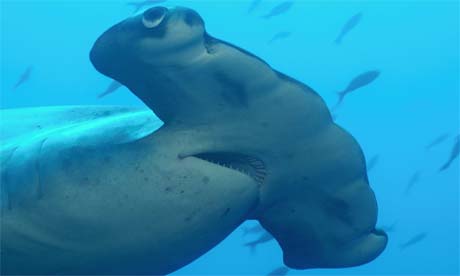Form & Function
Obviously the adaptation of the hammerhead possessed by
the Sphyrna lewini is a very intriguing one. The
outward extensions of their head that make up the
“hammer” are known as cephalofoil. By definition, the
prefix "cephalo" means "head" (Kaijiura and Holland
2002). Obviously this form has a lot to do with
biological adaptation.
Despite being around for a long while, the function of
the cephalofoil is still highly debated. In reality, it
has multiple purposes.
One of these functions is improved binocular vision. We
as humans also use this type of vision. Binocular vision
forms two overlapping views, one from each eye, and
creates depth perception. The position of the Sphyrna
lewini’s eyes on the sides of their hammerheads
creates greater binocular vision which obviously helps
them when hunting for prey (McComb et al. 2009).
Another function related directly related to the
organism’s cephalofoil is quicker, sharper turning. The
properties of the cephalofoil make the shark much more
hydrodynamic. This decreases resistance in the water,
thus allowing them to make very quick and sharp turns
while hunting for prey (Lim et al. 2010).
It doesn’t seem as though the scalloped hammerhead shark
needs another hunting advantage, but it has one in
electroreception. Electroreceptors allow the sharks to
detect electric fields and thus locate prey in the
water. Once again the cephalofoil provide an advantage.
They increase electrosensory area for the Sphyrna
lewini (Kaijiura and Holland 2002).
As I have stated previously, this organism’s cephalofoil
make them very hydrodynamic. This adaptation also comes
into play in the olfactory or smell sense. A narrow
groove in the cephalofoil allow a very large volume of
water to enter the body. The olfactory organ of this
organism just so happens to have an abundance of
lamellae which play a role in surface area of the
olfactory nerves (Rygg et al. 2013). More specifically,
the basic role of lamellae is increasing the amount of
oxygen in the bloodstream. (Rygg et al. 2013).This means that the
hammerhead shark can take in a lot of water for its
above average sense of smell.
Sphyrna lewini have clearly come a long
way in adapting to their aquatic environment. The
“hammer” formation has multiple purposes which
ultimately give the organism several advantages in
catching prey. These adaptations help to mask the
species’ lack of size when compared to other types of
sharks.
